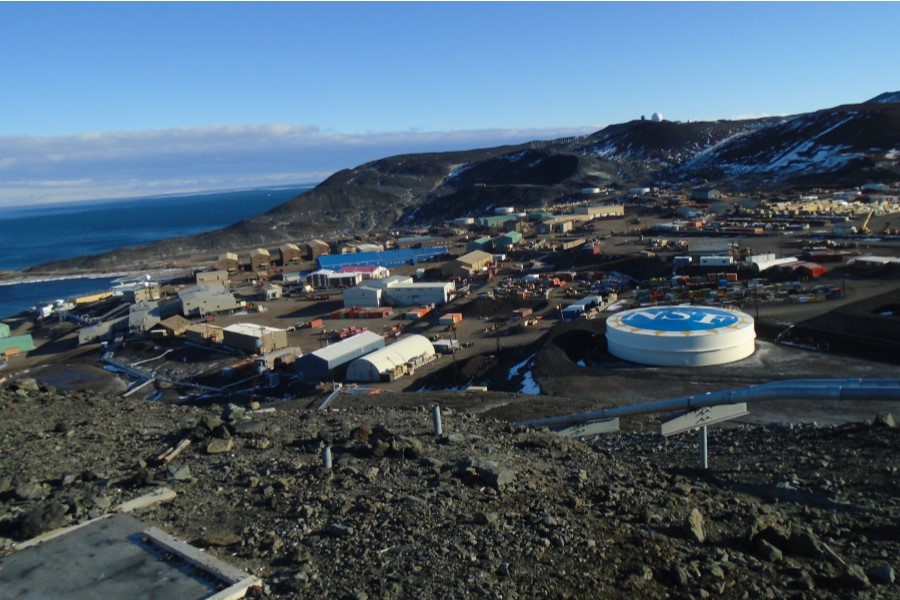The Supply Chain at the End of the Earth (1 of 3)
November 15, 2016 By: Senior Management | Topics: Project Support & Management, Supply ChainThis three-part series explains Sedlak’s work in support of the Antarctic Infrastructure Modernization for Science (AIMS) project of the U.S. Antarctic Program (USAP) to redesign and reconstruct McMurdo Station on Ross Island, Antarctica. Sedlak’s focus is on optimizing the supply storage facilities and processes. Part 1 describes the adventure of our team’s site visit to the continent and an overview of the history and environment of McMurdo Station.
Part 1 – The Adventure
“Nothing really prepares you for a trip to Antarctica,” explains Sedlak manager Dennis Heppner. Antarctica is the highest, driest, coldest, windiest and emptiest place on the planet. The ice that covers 99 percent of the continent is nearly three miles deep at its thickest points and ambient temperatures top off at 50°F in summer and -56°F in winter when the continent experiences six months of darkness, and it is subjected to blinding snowstorms year round. The extreme conditions and remote location mean very few people ever set foot on it. However, it is an international site for research in biology and medicine, atmospheric, earth, and ocean sciences, and aeronomy and astrophysics.
Sedlak was engaged to support the U.S. Antarctic Program’s Antarctic Infrastructure Modernization for Science (AIMS) project – a comprehensive, multi-phased reconstruction of McMurdo Station, which is the logistics and operations hub supporting research on Antarctica. The project’s mission is to upgrade the station’s infrastructure and layout to increase operational efficiency, improve quality of life, and ensure the station remains a viable platform to support Antarctic science for the next 35-50 years. Sedlak’s focus is optimizing warehousing and delivery processes to reduce the storage footprint, lower staffing requirements, and enhance service levels.
The first step – a site visit – was far from ordinary for the Sedlak team.
“The process of obtaining the proper clearances and then the logistics of the trip itself are pretty mind-boggling,” Heppner says. Sedlak’s team had to rush through a set of extensive medical/dental exams and background checks to meet a tight timeframe for a 10-day site visit to McMurdo in late February before winter arrived at the start of April. The clearances were necessary to ensure team members were healthy enough to travel to such a remote location, as medical services at McMurdo are limited and medical evacuations are both expensive and labor intensive. An evacuation in the dead of the Antarctic winter in June of this year made headlines across the country.
Once cleared, the team prepared for an arduous journey “to the ice” as the continent is often called. On Day 1, the team flew from Cleveland to Los Angeles, then boarded a flight to Christchurch, New Zealand, during which they crossed the international dateline and lost an entire day. In Christchurch, they were outfitted with appropriate gear from a dedicated supply depot, which included a parka, knit hat, gloves, wind pants, and goggles. The team then boarded an LC-130 for the 8-hour flight to McMurdo station, finally landing on skis on an ice runway at McMurdo.
“I never pictured myself going to Antarctica, but I definitely didn’t imagine going there in the back of a military cargo jet outfitted with skis,” says Sedlak consultant Shawn Sedlak. “While not the most comfortable ride, it was still really a ‘wow’ moment.”
Altogether, the team covered 28,000 miles and spent over 60 hours in the air.
“We were really going into an unknown,” Heppner says. Photos, web searches, even discussions with station personnel couldn’t paint a true picture of the actual environment. “People have this mindset of Antarctica as nothing but snow and ice,” he added, “but McMurdo Station itself sits on a volcanic island (Ross Island) which was more like a desert – dry, windy, dusty…but cold. There was ice on the water and the snow covered mountains were off in the distance.”
Antarctica is governed by the Antarctic Treaty, an international treaty signed in 1959 by 12 nations that establishes the continent’s use for peaceful purposes and prohibits any military presence or activity except in the support of scientific research. McMurdo Station was built in the 1950s as a temporary base camp for the construction of the South Pole Station, but remained in place due to its success in supporting ongoing research.
 Today, McMurdo is the logistical center of the U.S. Antarctic Program’s research operations. The station consists of over 100 buildings, some of which date back to its founding, on a 49-acre site that reflects six decades of limited planning. It is supplied by a single annual cargo vessel with 400-500 containers, additional bulk break cargo, and a tanker with approximately five million gallons of liquid fuel. Additional supply is provided as needed by a variety of aircraft from Christchurch and Hobart, Tasmania, Australia. During the summer, which is the research season, the station houses a population of approximately 1,000 researchers and support staff.
Today, McMurdo is the logistical center of the U.S. Antarctic Program’s research operations. The station consists of over 100 buildings, some of which date back to its founding, on a 49-acre site that reflects six decades of limited planning. It is supplied by a single annual cargo vessel with 400-500 containers, additional bulk break cargo, and a tanker with approximately five million gallons of liquid fuel. Additional supply is provided as needed by a variety of aircraft from Christchurch and Hobart, Tasmania, Australia. During the summer, which is the research season, the station houses a population of approximately 1,000 researchers and support staff.
“What people do there in support of the science is really amazing,” Heppner says. “Their mission is to get people there, get them outfitted, get them everything they need so they can go into the field and do the science and do it safely.”
Everything this equivalent of a small town requires – food, carpentry supplies, plumbing equipment, vehicle parts, all the way down to laundry detergent and toiletries – as well as field supplies to support the research camps (tents, equipment, backpacks) arrives in the annual cargo supply vessel. The station is unique in that it produces its own potable water by a reverse osmosis water plant and provides power via a hybrid electrical system that uses both diesel generators and wind energy. All waste produced on the station is containerized and removed once a year by the same ship.
McMurdo station itself is exceptional for its role in supplying all research on the continent in this manner, as well as for the fact that is was never meant to be a year-round, top-end station.
“It reminds you a little bit of frontier days,” Heppner says. “People make do with what they have. They’ll cobble things together to keep a piece of equipment running or repair a building. A lot of that obviously is due to the uniqueness of their supply chain. One, it’s very long supply chain with very little technology to support it. Two, the supply vessel and the fuel vessel come down only once a year in February. A lot of planning is required.”
The mindset of the people who work long-term on the station is also unique.
“Perhaps because it is so remote and so different, the people are unconventional,” Heppner explains. “They have a saying down there that you go the first year for the adventure, the second year to make money, and the third year because by then you don’t fit in anywhere else.”
Part 2 of this series will explore in more detail the supply chain challenges at McMurdo Station.
Read the next post in this series here.
For over 60 years Sedlak has developed independent and innovative supply chain solutions to companies across industries and around the world. We specialize in distribution and logistics with experts who deliver actionable solutions that bring meaningful results. If you would like to learn more about how Sedlak can help your business, fill out the contact form below.







